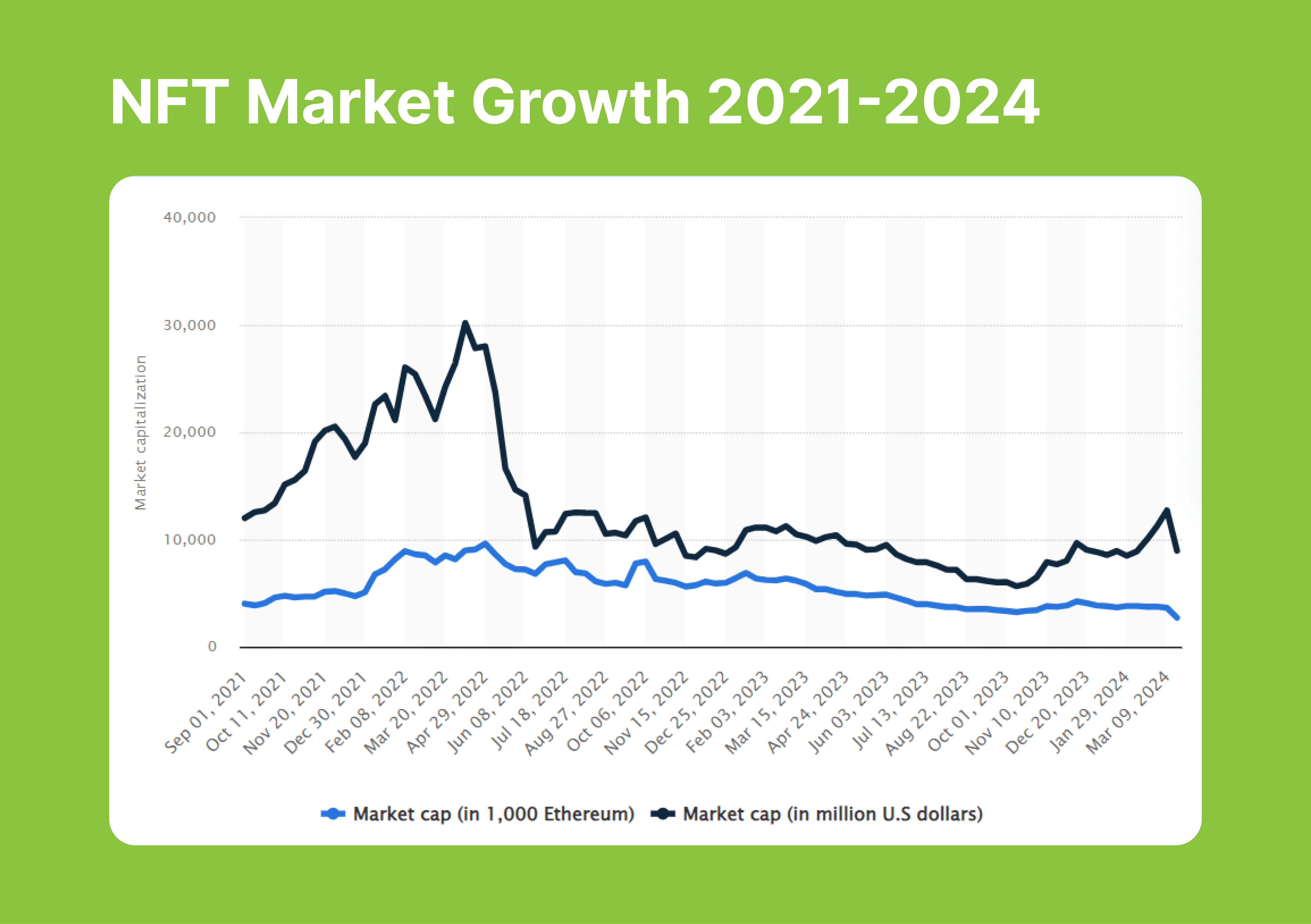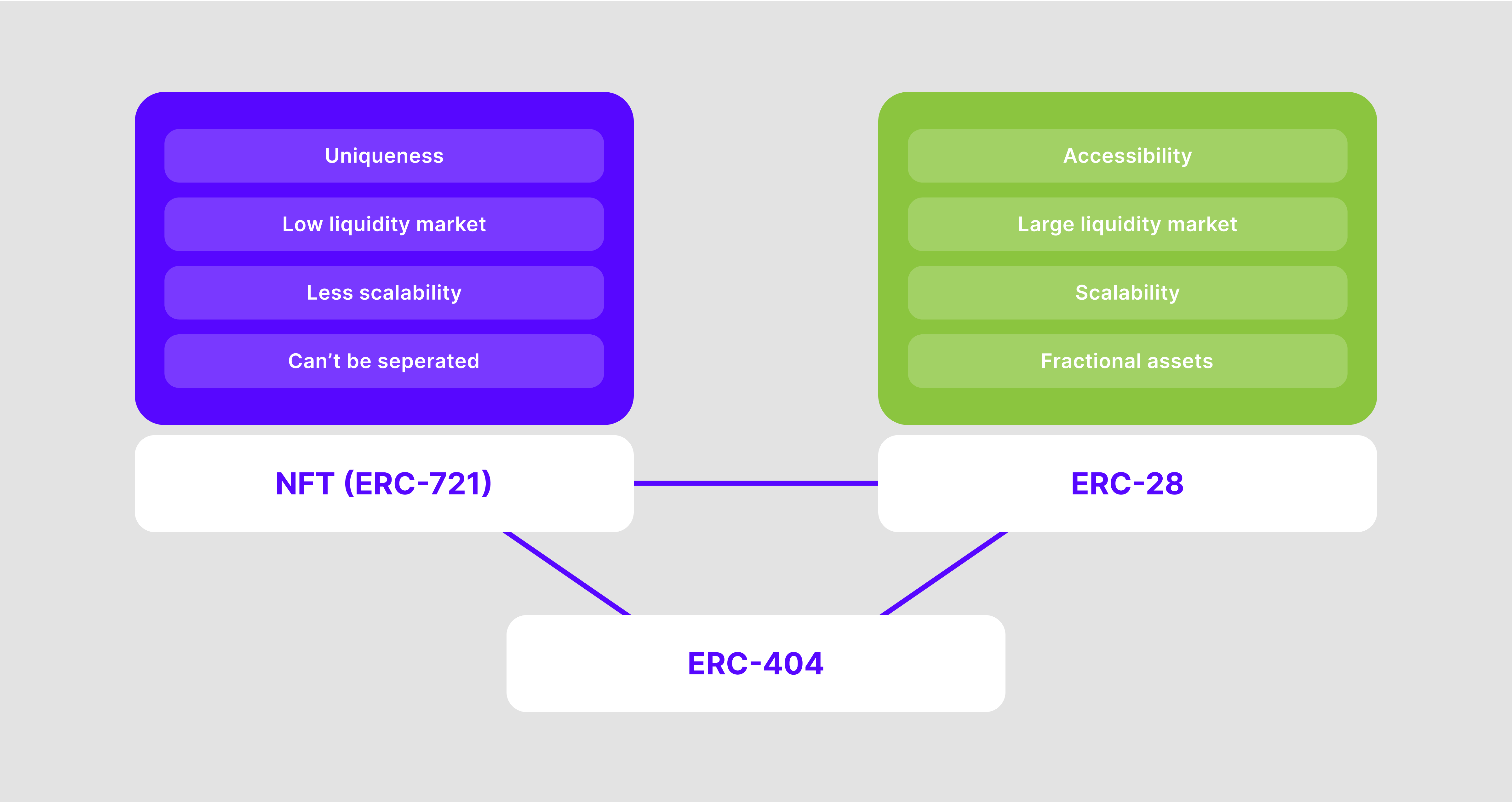One clear feature of decentralized economies is the swift implementation of robust technologies, surpassing expectations for cryptocurrencies and blockchains.
Because of the rapid expansion of these industries, technology is consistently faced with modern-day security and capacity issues. Notably, Ethereum – the second biggest blockchain platform and a significant player in the development of DeFi systems – has recently introduced an advanced feature for its decentralized setup.
The ERC-404 standard is a recent addition to Ethereum’s toolkit, offering valuable functionalities that blend fungibility and non-fungibility. Let’s explore the capabilities of this new ERC-404 contract.
Key Takeaways
- Ethereum announced a new experimental ERC-404 standard that combines ERC-20 and ERC-721.
- The new ERC-404 offers a mixture of fungible and non-fungible tokens.
- ERC404 tokens are expected to allow fractional NFT ownership, boost NFT funding pools, and improve the utility token ecosystem.
Understanding the ERC 404 Standard
In simpler terms, Ethereum standards and token standards define the rules for how cryptocurrencies, tokens, and decentralized applications (dApps) on Ethereum are created, transacted, and managed.
In simpler terms, each standard represents a specific set of guidelines or rules for a particular function or feature within a given system. For instance, ERC-20 standards define the way tokens are created on the Ethereum network, while ERC-4337 standards focus on the implementation of ETH multi-signature wallets.
The innovative ERC404 standard combines the attributes of both fungible and non-fungible tokens from ERC-20 and ERC-721 respectively. Essentially, it merges the features of traditional crypto tokens and unique non-fungible tokens.
With this innovative solution, digital assets acquire the tradability traits of cryptocurrencies, combined with the exclusivity attributes of NFTs. As a result, it becomes feasible for individuals to own fractions of NFTs, digital artwork, and other rare intangible possessions.
In the end, this could pave the way for innovative methods of exchanging premium digital assets and revitalize lackluster NFT marketplaces.

How Does The ERC-404 Tokens Work?
ERC404 coins offer the ability to own fractions of digital assets through smart contracts and collective ownership tokens. In simpler terms, each token represents a proportionate share in the underlying asset.
In the Ethereum token standard experiment, investors could have a role comparable to stock ownership. They’d acquire tokens representing a portion of an NFT’s value. If an investor buys all the available tokens, they gain complete ownership over the associated NFT.
Integrating ERC-20 and ERC-721 Standards
The new standard introduces a novel approach by generating interchangeable tokens and linking them to a distinctive non-interchangeable asset. This expansion brings more versatility and possibilities to asset possession within decentralized environments.
NFT trading and minting now offer additional features, following a recent decline in activity. This period saw a significant surge in transactions valued at approximately $18 billion between 2021 and 2022.

Flexible NFT Ownership
Owning a fraction of an NFT (Non-Fungible Token) can increase the desire for well-known collections and unique tokens. Furthermore, the use of NFTs as an unusual form of token standard opens up new possibilities for shared ownership of digital assets, communities, and utility tokens.
Scalable Token Minting
With the latest ERC440 standard connecting NFTs and fungible tokens, trading fractions of the latter results in the destruction of NFTs to preserve an optimal equilibrium.
A flexible supply of this nature can benefit various decentralized apps and cryptocurrency initiatives, drawing in investors and speculators who can purchase and trade fractional units. This, in turn, generates interest in the fundamental asset.

Use Cases of The New ERC Token Standards
The introduction of the latest NFT and crypto token issuance method expands the scope for potential investments in this space, enhancing opportunities for DeFi projects and utility tokens within specific metaverses or virtual property markets.
Combining traits of both fungible and non-fungible tokens leads to an abundance of applications, enriching the creator economy in a decentralized environment and enhancing the virtual world’s foundation. The primary functions of these semi-fungible tokens can be summarized as follows:

- Digital Art & Collectibles: The new ERC-404 standards make indulging in digital artistry more accessible. Under these standards, more than one user can collectively share ownership of a rare collectible item or a digital drawing.
- Decentralized Liquidity Sourcing: New established crypto projects and applications can pursue public investment through decentralized funding sources.
- Crypto Games & Metaverse: Play-to-earn gaming and virtual worlds can offer an extended utility to their central crypto token by combining cryptocurrencies with NFTs.
- Investing in Real Estate: Virtual property has been attracting top investors and celebrities. However, enabling fractional ownership opens the door for more participants to claim their shares.
Fast Fact
In 2022, the demand for Metaverse property skyrocketed as celebrities began purchasing virtual land. A buyer spent an impressive $450,000 to become Snoop Dogg’s neighbor in this new realm of real estate.
Projects Built on The ERC-404 Tokens
After the introduction of the ERC-404 standard, numerous crypto initiatives and tools have surfaced, featuring their unique native tokens which bring together the distinct advantages of Non-Fungible Tokens (NFTs) and Fungible Tokens (FTs).
Pandora ERC-404
Although not an officially recognized token standard, the Pandora cryptocurrency initiative was founded with the ERC404 framework in mind, providing similar advantages to fractional Non-Fungible Token (NFT) ownership.
Around ten days after the project’s initiation, the token value surpassed $30,000, piquing crypto community interest due to the advanced functionalities offered by ERC404 coins. The price subsequently dropped, but it has stayed above $10,000 since then.
Defrogs ERC-404
The Defrogs project built upon the achievements of the Pandora ERC404, yet it presented a distinct proposition. Defrogs introduced an NFT collection comprising 10,000 unique profile pictures. Users could purchase a token to mint and acquire fractional ownership of a Defrog PFP.
After its launch, the cost of this project skyrocketed, reaching an astonishing $3,400. But afterwards, its price significantly dropped, and it exchanged hands for under $1,000 throughout March 2024.
Anon ERC-404
Anon ERC404 is yet another crypto initiative introducing ERC404 through the provision of NFT gaming cards. Each token purchase results in the acquisition of a randomly assigned NFT gaming card, which is then burned and transferred to the buyer’s possession.
The price of Anon tokens initially stood at $17,000 upon release. Shortly afterwards, the value plummeted to around $2,000 for about a month. By the close of March 2024, the token’s value had further dropped to $12.
The Future of The ERC-404 Coins
An Ethereum proposal update cautions that the ERC404 contract remains an experimental endeavor. Yet, various networks have emerged to implement it, showcasing its unique capabilities. However, our observations suggest both notable advantages and limitations for this standard.
Possibilities
- Buying and selling NFTs to liquidity pools without having to find a new direct owner.
- The ability to buy/sell fractions of digital arts, assets, and NFTs.
- Boosting the use cases of NFT arts and marketplaces.
Limitations
- As an experimental token, dealing with ERC404 projects might not be safe yet.
- Use cases are still theoretical and lack practical uses that may reveal a few vulnerabilities or potential security risks.
Conclusion
The Ethereum ERC-404 standard represents a fresh token methodology, blending elements of both the ERC-20 and ERC-721 frameworks. As a result, it provides an intriguing combination of interchangeable (fungible) and unique (non-fungible) tokens.
The blend of crypto tokens and novel NFTs is expected to offer distinctive uses with advantages from token monetization and NFT scarcity.
ERC404 coins offer various benefits, including the ability to divide NFT ownership into fractions, expanding NFT trading markets, and creating new opportunities for creators in metaverse initiatives and crypto gaming industries.
Although this experimental standard is ongoing, numerous initiatives have emerged to apply this token type in real-life projects.
Read More
- LDO PREDICTION. LDO cryptocurrency
- JASMY PREDICTION. JASMY cryptocurrency
- Can Ethereum ETFs outperform Bitcoin ETFs – Yes or No?
- Chainlink to $20, when? Why analysts are positive about LINK’s future
- Citi analysts upgrade Coinbase stock to ‘BUY’ after +30% rally projection
- Why iShares’ Bitcoin Trust stock surged 13% in 5 days, and what’s ahead
- Spot Solana ETF approvals – Closer than you think?
- Orca crypto price prediction: Buying opportunity ahead, or bull trap?
- Top 10 Stocks and Crypto Robinhood Alternatives & Competitors
- ‘China’s going to have it’ – Donald Trump crypto stance, finally explained
2024-04-15 20:58